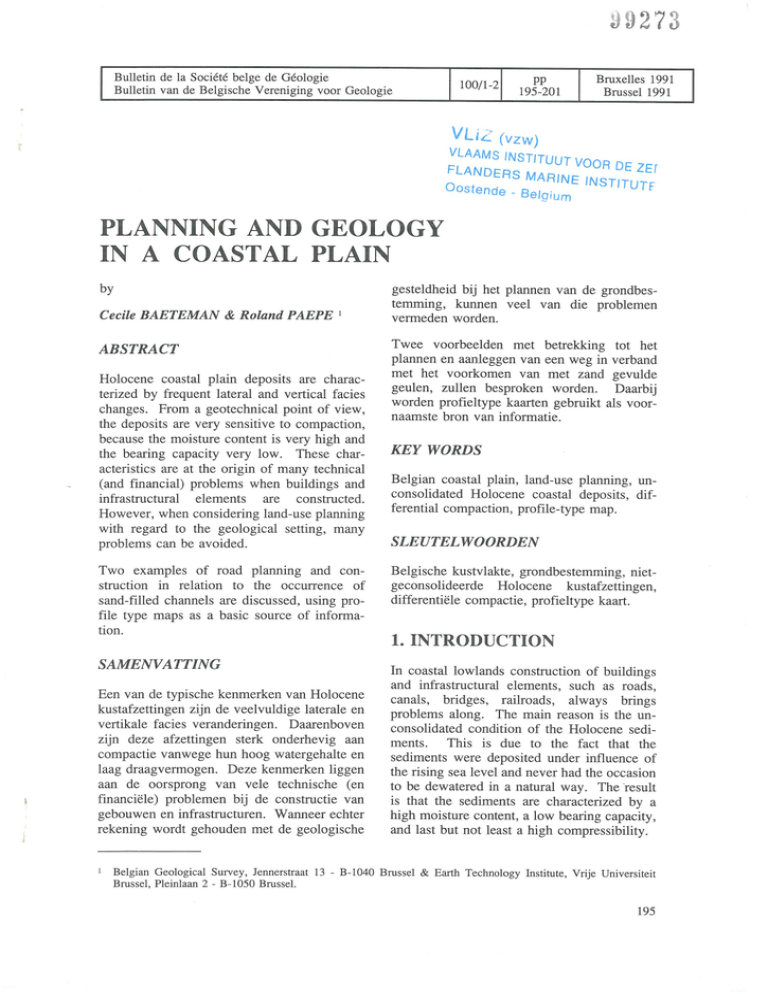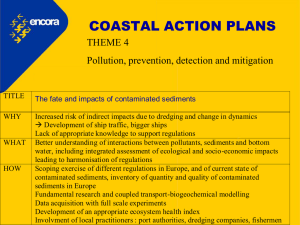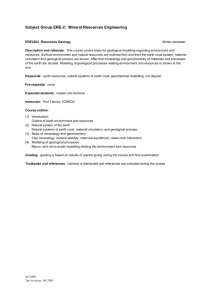^DffisM-^E; ^AMS,NST,TUUTVOOR 99273 oostende - Befgi
advertisement

99273 Bulletin de la Société beige de Geologie Bulletin van de Belgische Vereniging voor Geologie pp 195-201 100/1-2 Bmxelles 1991 Bmssel 1991 ^ VL<£1- -Lt (vzw) ^AMS,NST,TUUTVOOR DEZEf ^DffisM-^E; oostende - Befgi urn PLANNING AND GEOLOGY IN A COASTAL PLAIN by Cecile BAETEMAN & Roland PAEPE ABSTRACT Holocene coastal plain deposits are characterized by frequent lateral and vertical facies changes. From a geotechnical point of view, the deposits are very sensitive to compaction, because the moisture content is very high and the hearing capacity very low. These characterisücs are at the origin of many technical (and financial) problems when buildings and infrastructural elements are constructed. However, when considering land-use planning with regard to the geological setting, many gesteldheid bij het plannen van de grondbestemming, kunnen veel van die problemen vermeden worden. Twee voorbeelden met betrekking tot het plannen en aanleggen van een weg in verband met het voorkomen van met zand gevulde geulen, zullen besproken worden. Daarbij worden profieltype kaarten gebruikt als voornaamste bron van informatie. KEY WORDS Belgian coastal plain, land-use planning, unconsolidated Holocene coastal deposits, differential compaction, profile-type map. problems can be avoided. SLEUTELWOORDEN Two examples of road planning and con- Belgische kustvlakte, grondbestemming, nietgeconsolideerde Holocene kustafzettingen, differentiële compactie, profieltype kaart. struction in relation to the occurrence of sand-filled channels are discussed, using profile type maps as a basic source of informa. üon. SAMENVATTING Een van de typische kenmerken van Holocene kustafzettingen zijn de veelvuldige laterale en vertikale facies veranderingen. Daarenboven l. INTRODUCTION In coastal lowlands construction of buildings and infrastructural elements, such as roads, canals, bridges, railroads, always brings problems along. The main reason is the unconsolidated condition of the Holocene sedi- zijn deze afzettingen sterk onderhevig aan ments. This is due to the fact that the compacüe vanwege hun hoog watergehalte en sediments were deposited under influence of laag draagvermogen. Deze kenmerken liggen the rising sea level and never had the occasion aan de oorsprong van vele technische (en to be dewatered in a natural way. The result financiële) problemen bij de constructie van is that the sediments are characterized by a gebouwen en infrastructuren. Wanneer echter high moisture content, a low hearing capacity, rekening wordt gehouden met de geologische and last but not least a high compressibility. Belgian Geological Survey, Jennerstraat 13 - B-1040 Bmssel & Earth Technology Institute, Vrije Universiteit Bmssel, Pleinlaan 2 - B-1050 Brussel. 195 But the deposits of a coastal plain are also characterized by frequent and significant changes in lithology (Baeteman, 1987). Complex altemations of peat, clay, silt and sand are moreover cut by highly irregular pattems of sand-filled fossil channels. All these different lithologic units bear their proper geotechnical characteristics. Consequently in a coastal plain the geotechnical properties of the sediments are different from place to place. The decisive property with respect to these changes undeniably is the compressibility, leading to differential compaction when dewatering and/or loading the deposits. Civil engineers are very well aware of these geotechnical characteristics ; the high variability and complexity of the sediments are not so well known. Nowadays the engineering technologies allow to solve most of the problems. The question however is, at what price. The difficulties during and after the construcdon of infrastructural elements and buildings are not just a technical problem ; it is much more a social problem. From govemmental side a lot of money is invested. But also private land owners frequently experience how the house of their dreams literally and figuratively falls down because of geological ignorance of the architect and building contractor. Men have to abandon their plan be- cause they are in the impossibility to bring in the extra funds necessary to cover the unexpected technical problems. Dramatic consequences in such a situation are not to be neglected. How the proper use of adequate geological information can contribute to our society will be demonstrated by means of an example conceming road building. It should be men- no response could be offered due to a shortage of scientific staff. Once the infrastructure is planned and constmction is decided, soil investigations are carried out, but purely from an engineering point of view. In the case of a road or motorway such investigation consists of the execution of cone penetration tests every 100 m along the proposed route. In addition shallow barings are carried out at regular distance ; in general every 100 or 200 m. The main purpose of these barings is to carry out geotech- nical analysis. The borings are all attending more or less the same depth (ca 10 m) inde- pendent on the geological setting and revealing samples each half a metre. So far, the geology is not involved in the soil investigaIt is true, engineers still have much more faith in hard figures and diagrams provided by the analysis rather than in the destion. criptive texts and interpreted cross-sections from a geologist. Besides they trust that these figures give the sufficient information. It is more a coincidence rather than the mie that the Geological Survey is informeel about the existence of boreholes which can be stu- died if interested. It frequently happened that the road was already in use before a geologist from the Survey ever saw the samples from the barings. Even, many roads and bridges have been constructed without any geological advice at all. However, a proper knowledge of the detailed geological conditions can contribute a lot to the preliminary investigation. Moreover, the geological knowledge, as it is available at the Survey, can help to a great extent to avoid technical problems, especially by advising the planner for the selection of suitable locations for the infrastmctural elements with respect tioned that the discussion is related to the ex- to the particular geological condiüons. The perience in the coastal plain only. following example, one among so many, 2. THE STATE OF THE ART The planning of infrastructural elements in Belgium is based on a series of rigid elements such as economy, populaüon, politics and not at least landed property. However, geology does not belong to the primary factors influencing the planning. Although the Belgian Geological Survey was consulted while the land-use maps for the country were designed, 196 clearly illustrates the importance and benefit of the geological information. 3. THE CASE At the end of the seventies a motorway was constmcted in the western coastal plain of Belgium, more particularly between Oudenburg and Nieuwpoort (fig. l). It is a section of an important motorway usually called the "Brugge-Calais motorway" planned to open ^ l f ^ N t Knokka / / f l ^ A .""NEDERLAND ^ / Si <h ^ NOORDZEE » ^ \ Oostende . Oudenbur^ Brugge . o* ^--'' ^ * wf^oyt^ . ^ ^^ «^ ff * ê / l Leke Veur^ie' '.^ < * l l » r-^i Dik sm ui Lo . % o t FRANCE \ 5 10 km l o ^ 5.0 km ^ ^ / » surveyed are.a ------- motorway Figure l : Location of the Belgian coastal plain with indication of the surveyed areas. the western coastal plain and to establish a delkerke) which now will become one of the better connection with France. money swallowing roads because of the re* To construct the road, about l to 2 m of the * .i. current maintenance costs. superficial layers are removed and replaced by sand, forming a cunet in this way. Then the cunet is raised by more sand for l to 2 m for several months in order to achieve a pre- This section of the motorway forms a clear example of how the use of geological infor- load of the unconsolidated sediments. Such implication dwing and after the construction just by selecting the appropriate location of a method, which is indispensable for unconsolidated sediments, requires a huge amount of infilled sand. The removal of the superficial layers is done very systemaücally until a certain depth without taking into account the nature of the sediments. It already has been observed that only the upper part of a 2 m thick peat layer, which locally occurs slightly deeper than in general, was removed. In such a situation the cunet is not very functional since half of the peat layer, being the most sensitive to compaction, is still present. . mation can contribute to decrease the techni- cal problems as well as the financial the road in relation to the geological setting. Moreover a huge amount of the aü-eady scarce raw materials, like sand, could have been saved as well. A simple consultation of the renewed geological profile type map (available at the Geological Survey), and even of the well known pedological map, would have highlighted how unfortunate the location of this motorway section has been planned. Since some years now the road shows the Ah-eady in 1984, Hageman discussed extenwell known "washboard" phenomenon due to sively the problem of site location for builddifferential compaction (Hageman, 1984). ings and infrastructural elements in coastal This can be observed especially in the central lowlands. The author mainly stressed on the part of the surveyed route (at the exit Mid- fact that suitable geological pattems with res197 EME wsw T t m -h ït-l m -t-MAP NAP 0- (t 1^ -o t /' <<' 2 -'é. \ -1+- < '\ ^ ^. -6 - -l4 -6 * s&nd, sllt, clay p e at . e a! -10 50.0 o l -10 r~~"i tidal channel facies [. '_ .J Pleistocene sediments Figure 2 : Cross-section along the motorway delineating the highly variable relief of the Pleistocene subsurface and the frequent changes in facies in the Holocene sequence (The barings have been carried out by the Rijksinstituut voor Grondmechanica). possible. This in order to avoid technical problems, but also to prevent financial fai- pect to the compressibility and hearing capacity of sediments should be used whenever i f> If ^. ^- .^.^^/^w^^^^^^^^^^'^^ï.^ ^ ^ -fr *. f» ^ ff-' «^ ^ / * * B' .--^ J -- .^* ^ * < < ''^tö^!^;^ ;.-t: s n s AC:'" 1 . J ^ 1<;' *. <r*T l '--. ï^ï 1 < i.. ^"' ,.%!.? n ff t .»» . '* .'*'*'t~I~*~* *"»"<"»"f'.^* '*' *-'L* .' *' *T*'^'t t"»' * '. l'r f~* * .' *' * v' * *'*'* t_* '*' .' '.' '* »'*"<".'*'*'» *' '*' *~* .' * *_l'*_< * *~^ * *'*T<~»~* '< '. *' *'*"."*"* '* *Ï**'t* it/'-y ropping Pl^isïocene n s e airaent 3 V» QUÏ ^h <^ 3XPLA:;AT:0;I ^ -\ OF PROF:L3 TYPES '-T/-- 1 ^ » locene deoosit s mot^ o rw ay *> m *'. * c-lay^ j * . 9 alternaT. i-.'e -! J^ ^<* - UI /Y/ / w" -^ pe a ^ '^ A A' ..:r033-30Ct:l ' "*\ ti d al channel - ^ t' a, c i s 3 -M LU FW^ 1 -^ ? l e l s t o c e ne deao sit 3 7-777 pi +.. r'leistoc . Qne ^ ^_ su'osurfaee Figure 3 : Simplified profile-type map of the coastal plain east of Nieuwpoort with indication of the motorway. Aiï altemative location is proposed in relation to more suitable road-building conditions of the geological setting consisting of mainly a sand-filled channel in the west and a thin cover of Holocene tidal flat deposits underlain by basal peat, in the east. 198 s/ n o c at i on < w T l4 _ m _4 m NAP NAP f) ^ ^ £1 o *f -n -2 - /^ --^ -l4 J borehole . / /. 4 - l clay tidal channel facies /: -b /. / < ^ * -8 ^ * 1 immnpeat < t * --6 Ple i stocene sediments . t o 500 m _-8 . t -10 J 10 Figure 4 . Cross-section of the Holocene sequence along the alternative location crossing a sand-filled channel in the west and a thin cover of tidal Hat clay overlying the basal peat in the cast. lures and the unnecessary use of raw materials. Utilization of sand-filled fossil channels as location for a road is one of the applicable « opportunities. The cross-section along the motorway (fig. 2) demonstrates in the first place that the Pleistocene subsurface has a highly variable relief. This is an important factor for road building, because these Pleistocene sediments, consisting of coversands, are known to be re- latively more consolidated, hence having a much greater hearing capacity than the coastal Holocene sediments. In the Holocene deposits quite a lot of variadons can be observed too. The eastem part of the motorway crosses twice a sand-filled channel. The sequence of the central part is much more complex and consists of an alternation of peat and clastic tidal flat sediments. Besides, the tidal flat sediments are charac- terized by frequent changes of sand, silt and clay layers with irregular geometry, all having different geotechnical properties. To the west of the studied section, the sequence consists of mainly sandy sediments overlain by one peat layer in turn covered by clay. ^ lithologic unit, will take place. This is not always so evident for the engineers carrying out the preliminary investigation. It is true, far too often the sediments underlying the upper peat layer are regarded as being homogeneous, hearing uniform geotechnical char» acteristics. The unfortunate location of the motorway is clearly illustrated by a fragment of the geological profile type map. For the sake of cleamess a very simplified profile type map (fig. 3) was drawn, based on the special profile type map made at the Geological Survey and showing the Holocene sequence in great detail. The simplified profile type map consists of only four profile types which however give sufficient informaüon for this purpose. Profile type # l represents a thin cover of clay sediments overlying directly the Pleistocene deposits. In # 2 a basal peat, with a thickness ranging between few cm and about l m, is covering the Pleistocene surface. In the areas where the Pleistocene surface is occurring at a greater depth, profile type # 3 is found consisting of an altemation of clay, silt and sand on the one hand, and one or more peat layers on the other hand. Basal peat may be It is obvious that dewatering and/or loading this road-section will unavoidably lead to Even if significant differential compaction. tidal channel facies. It should be mentioned the upper 2 m of sediments are removed and does not always consists entirely of homoge- replaced by sand, differential compaction occurring within a different timespan for each absent or present. Finally # 4 represents the that the sequence of these fossil tidal channels neous sand. At the outsides a sequence of clay with a thickness of several metres is fre199 profile type #1,2 and 4 will also here avoid differential compaction and high maintenance quently found. Such a kind of data is delineated on the special profile type map. costs once the road is in use. The simplified profile type map demonstrates that the concemed section of the motorway crosses for a great part profile type # 3, the area which is most sensitive to compaction. The geological setting of the region, however, offers more suitable areas and an altemative location is proposed (fig. 3). In the east, about 2.5 km more to the south of the mo- 4. CONCLUSION ^ Technical problems during construction and high maintenance costs of infrastructural elements are inherent to the geological condition But with the use of of coastal lowlands. torway, the Pleistocene surface, hence the relatively consolidated sediments, is at a high elevation. The Holocene deposits along that geological information, a great deal of the problems can be avoided and money as well altemative location are, in the eastern part, restricted to a cover of tidal flat clay underlain coastal lowlands in particular, it is of vital by a basal peat reaching a maximum thickness of l m (fig. 4). With respect to road-building, this part offers suitable conditions, because it has a good hearing capacity and very low compaction rate. Besides, a cunet would re- result in false conclusions. It is also insuffi- move all the compressible Holocene layers. More to the west the fossil tidal channel could be used as the central part of it is sand filled and requires only simple foundation engineering provisions. Very limited compaction would occur which moreover would happen very quickly (which is not the case for clay and peat). On the other hand these sediments will not yield differential compaction. This alternative location certainly would not result in a washboard-road, very important for the maintenance costs after few years. as raw materials can be saved. However, for importance that the geological information is detailed. Generalizing the interpretations and extrapolation over great distances can only cient to consider only the superficial layers. The three-dimentional distribution, or geometry of the different strata must be known. ^ ,E _?- . . ^r.*.'. t <*. . \" . . .~» *~ f . '. t f t » . t # . ^ t * .. \* . -; 4 t plished f acts, but to advice and inform ei vil engineers and planners before decisions are made. But the dialogue is not always evident. z^rA* . . < » * . . » ., m *^ * « .< t »* f . . ^- 4 f 3 2 1 -- . * ..»'»*.. . . .~»~^ * .t . < < . 77^\ ^ . . .~* ."J 1^*_*_<^ .:-?*:*:K f~_» # t l -^' ^ . . . :.;....? * * :.:.:';.:.?&<!; .^.L* . t'# v .*J . » * * **'^*"^ f . . . t . M t .'-*. u," t 'i.'* * * » . . . sm t t . . . » * t '#~_* * _ . ~_ f .-.-. .u. . . ?; . ^ » f .* l . '.* ~. * ._*i*'_* 9 » t . * se . '.fr t < *- . »- * * \ t',\-. \ y;£^r^ïl<-i> ^..- *^ \ '""f'" * :':-:-i-:-; 1,w. ~.*ir . * * -] * . < tt # . t * <'* '»*. t ^^s .*. ^. . * / '.f * f . t '^ . . . f . w .^< *~_f . fr t ._< .- t * t * * * t t < . :.**;ïl". . » t ï ^f^^: -T t . . . . . . . . L-= f . 4- -=a- . t < » . ..VWWi '^ . ^ ^ » t . t *^ -^- ^-^^f^-=--^y^s^siï-^ riEs? 'r^~ » . t *}.* *_* .-tl* * ~_ . ~_ » f~_*~_9 . ._»_. l »_»^* t n^^ < < . lu. * * f ...*. * <^^F^___ t t r.*. .' .Sa: . * 1 km --= -^ -T . . . . -s. . *~_9 * . * o o 'd . f . . . » * .- .t ,/ .K » . ==59C/. » . . . * *\*:** »r A E' . ^ ,.'.:.-f.-'7. < Hl KSSS \ planned road ,' *~_f ^.'^^ . .1*ï # t t f JS» . *~_* »^« . . < Ple i stocene * < . . . * -'"lu: 9~_* » .^ f . t . . . ^ s and T^ . t * a peat =itï t *^> *~.*L^ t * *~_f t^» ^ .L*-* .'.'*"' *L*L^ S^ë^ï. .iSê . . . ^ t ï, -T^". » . f-s^wms^ ..>:. »~* s<a ^_ SnSia3=0 t . ^* . »_. *L*i*i-T: t ^ \^\ clay !.: . . . . < . * » . . # . . . f' f ^ï. s? ~^£: ^3~~- * .TFt l ^ » F? t . . l t . . Shifting the location of the road slightly to the west and selecting the areas represented by . t . . «. *'. . . . . t f . ". the coastal plain, resulting in profile type maps, simplified maps can easily be made for the purpose of e.g. construcüon of infrastructural elements. An example is shown in fig. 5. A planned road, located north of Lo (fig. l), is crossing frequently different kinds of sequences, and more particularly the sequence consisting of an altemation of peat and clay. The washboard is guaranteed. * .*sï»* * .% ,; Thanks to the detailed systematic mapping in . » a . . . *:*,*».* l» *I*1* t ».".<.''* #~_*~_» fr < ~#* ^ . * . . S-; is not to study and discuss endless accom- . . . . . . . . ^r < .....-.'.v.y^g .'J'* * 'Ï'^ÏNV .'«v/. * The role and utility of the geologist, however, # ?.; * t '*'. * - . *.~tl^-*-*_* i^ ^' # But the road is constructed and the endless maintenance of the washboard can start. . f ;-A";'i;; # . A^ fr < * l This case study unfortunately is not unique. Legend . . . » 4 . » l# * . . . * . . * 200 rr # b.k. \ . . . J. ^ . .[. . . t t '*< ^ » # » tt » « . f 9'_f »_» l * t f~_f f t * »^ v~v~_* .'. *T*^* .7* ^ t . ..A * . * t # . t * . . t t t *.' ."*". *~_» t . Figure 5 : Example of a simplified profile-type map of the area south of Avekapelle (NGI Topographic Map : Lampemisse-Diksmuide). The map clearly exhibits the occurrence of an important sand-filled channel which could be use as base for the road. The planned road is redrawn from the Land-use Map (Gewestplan). . t T The only way to fulfil these conditions is offered by the profile type map, representing the entü-e sequence of a sedimentary body in a three-dimentional marmer. To be useful, the legend of the map must be drawn up in a comprehensive way. Plain descriptions of the sediments are preferable, rather than the clas- sical stratigraphical terms, meaningless to non-geologists. Such a geological profile type map, surveyed in detail, farms an inexhaustible basic source of information. Only on base of such a map, any kind of geologically related thematic map can be deduced quickly and easily, without any further intensive research. However, the maps should be consulted and used. Therefore their existence must be proclaimed broadwise. Civil engineers, planners, managers, decision makers and politicians should be aware of the technical and social REFERENCES BAETEMAN, C., 1981 - An altemative clas- sification and profile type map applied to the Holocene deposits of the Belgian coastal plain. Buil. Belg. Ver. Geol., 90: 257-280. BAETEMAN, C., 1987 - Mapping a coastal plain. Problems conceming mapping units. Geobound, l: 3-9. HAGEMAN, B.P., 1984 - Geological information, a vital element in environmental planning with emphasis on coastal plains. Geol. f.5., A75: 93-123. HAGEMAN, B.P., 1989 - The application of Quatemary geology in coastal areas. In : De Mulder & Hageman (Eds), Applied Quaternary Research, Balkema, 43-63. applicaüons of this source of geoscientific information. Only in that manner, land-use planning can be done in an efficiënt and res- ponsable way. Technical problems can be avoided, and raw materials can be saved. Hence financial failures are avoidable too. Manuscript received on 2 May 1991 and accepted for publication on 13 September 1991. ^ 201






